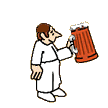  |
|
|
  |
|
|
| The
Beer Page! Boast your knowledge of beer... Life is rough!
I'm drinking
what!?!
Take this job
and drink it!
Did you know
. . .
Our Founding
Fathers
Now that's a
party!
Cold beer here!
Roll out the
barrel!
Some More Useless Information The patron saint of beer, Saint Adrian was put to death on March 3, 303A.D. Longevity - Waiters, bartenders and newspaper reporters do not rank particularly high on the longevity roster. They don't live as long, on the average, as college professors, mathmaticians and social workers. In fact they barely tend to outlive miners, who as a group don't outlive anybody, hardly. Why waiters, bartenders and newspaper reporters seem to survive about equally unwell is not known. But statistics indicate such. How do Hungarians fight a hangover. They put a slice of salami over a shot glass of vodka and then sip the vodka through the salami. The word Booze does not, as widely believed, come from a liquor bottle named E. C. Booz. The word is quite old, originating perhaps from the Dutch word buyzen, "to tipple," or the Middle English bouse, "to drink deep." We all recognize such words as plastered, under the table, soused, tipsy and bombed as slang for being drunk. How about these that have been dropped from the language bungey, nimptopsical, cherry-merry and as stiff as a ringbolt. Almost every country in the world utilizes some native product to make an alcoholic beverage. Asian liquors, disstilled from rice, from millit or from palm sap originated around 400 b.c. and their names - sautchoo, arrach, arika, and skhou. Around the year 300 Ireland brewed up some usquebaugh from oat and barley beer. Around the year 900 Italy began distilling grapes to produce brandy. Around 1500 the Scots got the hand of making whiskey from malted barley. In 1750 France distilled cognac from grapes. The state of Nevada allows the sale of liquor 24 hours a day, 7 days a week, 365 days a year. The drinking age is 21 years. In the last five years, Tokyo has reported twenty four deaths due to bowling related injuries. Spaghetti comes from China, not Italy and tomato sauce was created by Americans 200 years after spaghetti was invented. The house where Thomas Jefferson wrote the Declaration of Independence is gone and a hamburger stand now is on the property. |
Classic
Beer Drinking Games
Bizz Buzz Rules: Sit in a circle. First person starts
off by saying "one", second two, etc except that no numbers divisible by
three can be said. Instead of the number (e.g. 3, 6, 9 12, 15,...) the
player says Bizz and a trip around the circle Suck and Blow A classic game for the purpose of meeting people, not for getting drunk. Supplies needed: people of both sexes (depending on sexual preference) and something along the lines of a good sized index card or sheet of paper. Everyone sits in a circle, generally male - female. Someone chooses to start, and places the card against his/her lips, then using nothing but air pressure passes it to the person sitting next to him. This person takes the card by sucking on it and attempts to pass it to the next person, of course, never touching the card with hands. If the card is dropped during the exchange, those involved take a drink. Then the game resumes. Up and Down The River Quite an excellent game with a potentially very high buzz factor. Required materials: many people and at least two decks of cards. A good rule of thumb is one deck for six people, than an additional deck for every additional eight to ten people. Everyone sits in a circle, one player is the dealer as well as a participant. Each player is dealt four cards face up, to be kept in front of that player. The dealer then starts 'up the river' by turning over the first card, each player with the same card in front of him/her (suit doesn't matter), must take one drink. If the person has more than one of the same card, it is a drink for each card. The dealer then turns over the next card. Same thing, except this time it is two drinks. The next deal is three drinks, and the the last is four drinks. After the fourth card, the dealer returns 'down the river' by dealing the next card on top of the fourth card dealt. Players with matching cards now GIVE four drinks away in any combination; four to one player, or maybe one drink to four different players. Same situation of the player has more than one of the same card; the player gives drinks for each card. The dealer continues back 'down the river' by dealing the next card on top of the third card dealt. This time players give three cards for each matching card. The next deal is a give of two drinks, and the last deal is a give of one drink. After all the cards are dealt, simply shuffle and deal again. Play continues until everyone is sick of the game, or sick from the beer. The identity of the dealer changes with each shuffle. The dealer doesn't have a hand. Ways to raise buzz factor: Use two decks of
cards - This nearly quadruples the hits.
The History of Beer-Making Its Estimated that beer brewing began 4,500 years ago in Mesopotamian and Egyptian cultures. An accidental combination of Barley, water and wild yeast produced Nectar of the Gods. Other grains such as Millet, Corn, Rice, Wheat were also used. This strange concoction became highly prized and used regularly, particularly by royalty. Over time, households would customarily brew beer as a staple item. Throughout the world, especially in Europe, brewing transitioned from the household into the local town breweries. As some special brews became legendary and world commerce developed, distribution of beer spread to regions and even other parts of the world. One reason other the good taste and effects, beer was produced as a safer form of water consumption became many water supplies were of poor quality in many regions. Small Town breweries developed distinctive, regional styles of beer due to local traditions and special indigenous type of grains, hops, yeast and water availability. Some examples include Pilsener Urquell (Czechoslovakia, special water), Belgium Ales (unique yeasts and fruit flavoring), Wheat Beers (Germany, local high quality grain), Royal Bock (Einbeck Germany with high alcohol and good preservation qualities), India Pale Ale (British bitter, high alcohol, transported long distances to Troops in India). The combination of higher alcohol beers and the use of Hops helped significantly in preservation and allowed long transport. In America, prior to
and during prohibition, people brewed beer using marginal equipment and
ingredients. However, American Style beer in just 1 of over 20 worldwide beer styles, but recently, beer drinkers are demanding more variety and flavor in beer. Note the proliferation of Microbreweries in the U.S. and the large breweries now offering "special brews" to attract and retain a growing segment of the market. |
Beer Links
Click on the lables
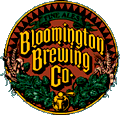 |
 |
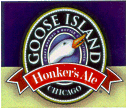 |
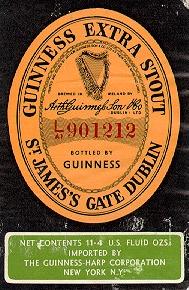 |
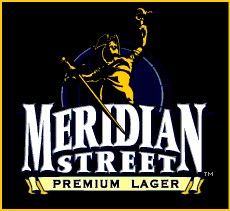 |
 |
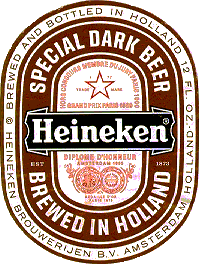 |